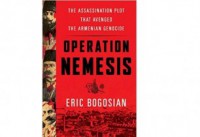 Vengeance is born when justice dies. “Operation Nemesis” is the gripping tale of how a small, ruthlessly determined group of Armenians hunted down the architects of the Ottoman Empire’s World War I program of organized mass murder, specifically intended to eliminate a people, the Armenians, who had lived in Anatolia and other parts of the Ottoman Empire for thousands of years.
Vengeance is born when justice dies. “Operation Nemesis” is the gripping tale of how a small, ruthlessly determined group of Armenians hunted down the architects of the Ottoman Empire’s World War I program of organized mass murder, specifically intended to eliminate a people, the Armenians, who had lived in Anatolia and other parts of the Ottoman Empire for thousands of years.
Many governments, spiritual leaders (including the current pope), and most independent historians and legal analysts agree that what began in Istanbul a century ago on April 24, 1915, was the first modern genocide. By the time it was over, best estimates are that 1 million Ottoman Armenians had been killed, starved or driven to their deaths — as many women and children as able-bodied men. Trials in Istanbul immediately after World War I convicted and condemned to death in absentia key members of the responsible Young Turk leadership, but political upheaval erupted before most sentences could be carried out. While Kemal Ataturk, founder of the modern Turkish republic, personally denounced the mass murder of Armenians as “a shameful act,” his and other successor governments never officially acknowledged what happened. In the perilous early days of the Turkish republic — a poor, war-ravaged country — denial was understandable if not justifiable. The first and only priority was to establish a cohesive Turkish identity to replace the conflicted racial and religious melange that was the Ottoman Empire.
This meant creating a cadre of Muslim Turkish doctors, engineers, artists, intellectuals, architects, bankers and entrepreneurs to replace the Christian Armenians, Greeks and other minorities who had dominated those fields throughout the Ottoman centuries. It also meant avoiding restoration of valuable farmland, commercial property and seized or looted personal wealth to the families of murdered or exiled Armenians at a time when the Turkish economy was struggling to survive. This, in turn, led to rewriting history and demolishing ancient churches and other traces of Armenian civilization that had stood for centuries before the first Turks set foot in Anatolia.
Today, Turkey is a prosperous regional superpower, but its government is still in deep denial. It is as if every postwar German government, from Konrad Adenauer to Angela Merkel, had denied the existence of Nazi atrocities and passed laws banning the discussion of Hitler’s crimes against humanity. Of course, no analogies are perfect. Even as the Young Turk leadership organized and carried out its program of mass extermination, a few Christian Armenians were exempted. A great uncle of mine, a palace architect to the sultan, was already serving as an Ottoman engineer officer when the mass murders — unbeknownst to him — began. His wife, as a senior officer’s spouse, was spared. Uncle Mihran ended up a British POW on the Arab front and would build a new life — and a distinguished architectural career — in America. To his dying day, he had nothing but respect for Kemal Ataturk as a brilliant soldier and nation-builder. Obviously, you wouldn’t have found any Jewish officers in senior German ranks under the Third Reich, and wives of purged Jewish officers would probably have perished in concentration camps.
But that hardly alters the big picture. The mass murders of defenseless Armenian civilians, deportations, abductions of children, unrecompensed confiscation of possessions, and deliberate failure to provide food or medical treatment to Armenian death marchers clearly qualify as genocide. Small wonder then, that in the absence of justice in the early 1920s, a handful of Armenian conspirators took the law into their own hands and hunted down several of the convicted mass murderers living comfortably in cities like Berlin. Sadly, theirs is a story with more villains and victims than heroes. In “Operation Nemesis,” Eric Bogosian, a successful playwright and novelist, portrays the revenge killers warts and all; they included at least one neurotic and one braggart who clearly enjoyed his work a little too much. Worse was to follow. As late as the 1980s, a handful of radical Armenian nationalists with Middle East terrorist links carried out murders of innocent Turkish diplomats, possibly with encouragement from behind the Iron Curtain.
Meanwhile, the bloody shirt of Talaat Pasha, one of the architects of the Armenian genocide — a man who gloated about it and even pressured U.S. Ambassador Henry Morgenthau to turn over any American life insurance benefits paid on the deaths of his victims — was placed on display at the Turkish Army Museum inIstanbul as evidence of Armenian atrocities against Turks; the equivalent would be a contemporary German museum displaying clothing worn by Adolf Eichmann at his execution as evidence of Jewish atrocities against Germans.
Justice has yet to replace revenge, but growing numbers of Turks are seeking — and speaking — the truth, even at the risk of jail. When Hrant Dink, a courageous Turkish-Armenian journalist I was privileged to know, was gunned down by an extreme Turkish nationalist in front of his Istanbul office in 2007, 200,000 mourners, overwhelmingly Muslim Turks, filled the streets carrying signs declaring “We Are All Hrant Dink” and “We Are All Armenians.” What better reminder that the sense of justice is often stronger in ordinary citizens than in politicians?





